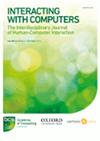How Motivation, Nomophobic Design and Environmental Demands Predict Students’ Media Multitasking when Participating in Online Courses During COVID-19: An Empirical Study with a HCI Time and Temporality Lens
IF 1.3
4区 计算机科学
Q3 COMPUTER SCIENCE, CYBERNETICS
引用次数: 0
Abstract
Abstract There is an emerging shift in human–computer interaction (HCI) research from things to events and towards time and temporality as a design material, which is made even more urgent by the unique time of the COVID-19 period. This paper pushes this shift forwards by investigating factors and the way that these shape online media multitasking behaviour over time during COVID-19. We model the factors along the WHAT and HOW dimensions of the HCI-over-Time model (HCIoT) with self-report data from 117 university students and objective behavioural data from 40 university students, who participated in an online course over 2 weeks during COVID-19. The results indicated a pervasiveness of media multitasking behaviour over time in an online course, driven by individual factors and enhanced by their mutual fit. Based on interpretation of our data, we suggest conceptualizing the COVID-19 period as the larger temporal environment in the HCIoT model. The discussion further explains how the broader idea of human–computer-environment fit is significant to understand HCIoT through an interaction lens. We discuss methodological issues related to differentiating between self-report and behavioural measures when applying the HCIoT model. The conclusion supports the feasibility and significance of conceptualizing media multitasking during COVID-19 as temporal HCI and of further developing and operationalizing the HCIoT model by using both behavioural and self-report measures.动机、无网络恐惧症设计和环境需求如何预测学生在COVID-19期间参与在线课程时的媒体多任务处理:基于HCI时间和时间性镜头的实证研究
人机交互(HCI)研究出现了从事物转向事件、转向以时间和时间性为设计素材的新兴转变,在新冠肺炎疫情的特殊时期,这种转变显得更加迫切。本文通过调查因素以及这些因素在COVID-19期间长期影响在线媒体多任务处理行为的方式,推动了这一转变。我们利用117名大学生的自我报告数据和40名大学生的客观行为数据,根据HCIoT随时间模型(HCIoT)的WHAT和HOW维度对因素进行建模,这些大学生在COVID-19期间参加了为期两周的在线课程。结果表明,随着时间的推移,在线课程中媒体多任务行为的普遍存在,这是由个人因素驱动的,并因它们的相互契合而增强。基于对我们数据的解释,我们建议将COVID-19时期概念化为HCIoT模型中更大的时间环境。讨论进一步解释了更广泛的人机环境契合概念对于通过交互视角理解HCIoT的重要性。在应用HCIoT模型时,我们讨论了与区分自我报告和行为测量相关的方法学问题。该结论支持将COVID-19期间的媒体多任务处理概念作为时间型HCI的可行性和重要性,以及通过使用行为和自我报告测量进一步开发和实施HCIoT模型的可行性和重要性。
本文章由计算机程序翻译,如有差异,请以英文原文为准。
求助全文
约1分钟内获得全文
求助全文
来源期刊

Interacting with Computers
工程技术-计算机:控制论
CiteScore
2.70
自引率
0.00%
发文量
12
审稿时长
>12 weeks
期刊介绍:
Interacting with Computers: The Interdisciplinary Journal of Human-Computer Interaction, is an official publication of BCS, The Chartered Institute for IT and the Interaction Specialist Group .
Interacting with Computers (IwC) was launched in 1987 by interaction to provide access to the results of research in the field of Human-Computer Interaction (HCI) - an increasingly crucial discipline within the Computer, Information, and Design Sciences. Now one of the most highly rated journals in the field, IwC has a strong and growing Impact Factor, and a high ranking and excellent indices (h-index, SNIP, SJR).
 求助内容:
求助内容: 应助结果提醒方式:
应助结果提醒方式:


